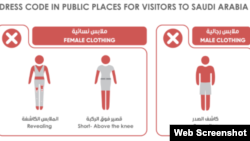On February 25, Globe Eye News, a blue-checked X account, claimed that Saudi Arabia’s Crown Prince Mohammed bin Salman Al Saud promised Saudi women the freedom to choose what to wear.
Global Eye News’ post, which had gained nearly 8 million views by the time of this writing, features a photograph of Prince Salman next to the picture of a group of women wearing black burkas, a type of loose female attire that covers entire body and face except for the palms.
The post states:
"Saudi Prince Salman: From now on, only Saudi Arabian women can decide what clothing Saudi Arabian women will wear."
That is misleading.
Polygraph.info could not find any recent interview with or statement by the Saudi Arabian prince about his nation’s dress code for women.
While Saudi Arabia does not have a law laying out a dress code for women, they are expected to dress in accordance with Sharia law.
Prince Salman made that clear in a March 19, 2018, interview with CBS:
“The laws are very clear and stipulated in the laws of Sharia: that women wear decent, respectful clothing, like men. This, however, does not particularly specify a black abaya or a black head cover. The decision is entirely left for women to decide what type of decent and respectful attire she chooses to wear.”
In saying that “the decision is entirely left for women,” Prince Salman seemed to be referring to the choice of color rather than the type of clothing, which he said is stipulated by Sharia law for both men and women.
X added a community note to Globe Eye News’ post, stating that it was “missing important context.”
Saudi Arabia’s Commission for the Promotion of Virtue and the Prevention of Vice, which is popularly known as the mutawa and functions as a religious police force, imposed a strict dress code on women and gender segregation between the early 1980s and 2010s.
While the religious police still exist, Saudi King Salman abolished the mandatory burka for women in 2015. In 2019, women were given permission to drive cars, wear colorful clothes instead of black burkas, and choose different clothing styles and designs.
Still, women in Saudi Arabia remain restricted in their choice of clothing, and many designs are listed as prohibited. Among the banned items are clothes that reveal too much skin, garments that do not cover the knee or elbow, bikinis, and tight or see-through clothing.
Saudi Arabia also has dress code for foreigner visitors, called the “Public Decorum Charter,” which describes the types of prohibited clothing in both words and illustrations.
Foreigners are banned from wearing clothes bearing human photographs, human silhouettes, or signs and phrases that violate “common decency.”
Recent social media posts and YouTube videos show that more women in Saudi Arabia interpret the Sharia dress code liberally, with some abandoning head and face covers and even switching to modern clothing, while many continue to cover their bodies fully.
While Saudi Arabia's dress code is experiencing some reform, other Muslim nations, like Iran and Afghanistan, are moving in the opposite direction.
Afghanistan had liberal dress code from the early 1900s to the 1970s, when it was a kingdom.
In the 1920s, Queen Soraya Tarzi, the wife of King Amanullah Khan, emerged as a stylish and powerful figure in the Middle East. During her reign, King Amanullah Khan famously remarked, "I am your King, but the Minister of Education is my wife, your Queen."
Queen Soraya Tarzi was an exemplar of modern Afghanistan, establishing the first school for girls and launching the kingdom’s first women’s magazine in 1927, called Ershad-I-Niswan, or "Guidance for Women."
However, Afghanistan subsequently saw a regression in women's rights. After coming to power in 1996, the Taliban banned girls from attending schools. In 2021, after retaking power, they barred girls from studying beyond sixth grade, enforced stricter dress codes and imposed other limitations that led to the increased isolation of women from public life and narrowing professional opportunities.
In Iran, the religious police, bearing a name similar to the one in Saudi Arabia, is infamous for its brutal enforcement of the dress code for women.
With the regime’s encouragement, this morality police and its adepts have physically attacked women in Iran, with some having had flesh-eating acid thrown on their faces and others even beaten to death for wearing “loose hijabs.”
Thousands of Iranians protested in 2022, accusing the regime’s religious police of killing Mahsa Amini, a young woman who died in police custody after being arrested for wearing a loose hijab.
Iran’s Islamic clergy responded to the public unrest by introducing even stricter legal limitations on women and girls who violate the dress code, including punishments of up to 10 years in prison and fines of around $8,500.






